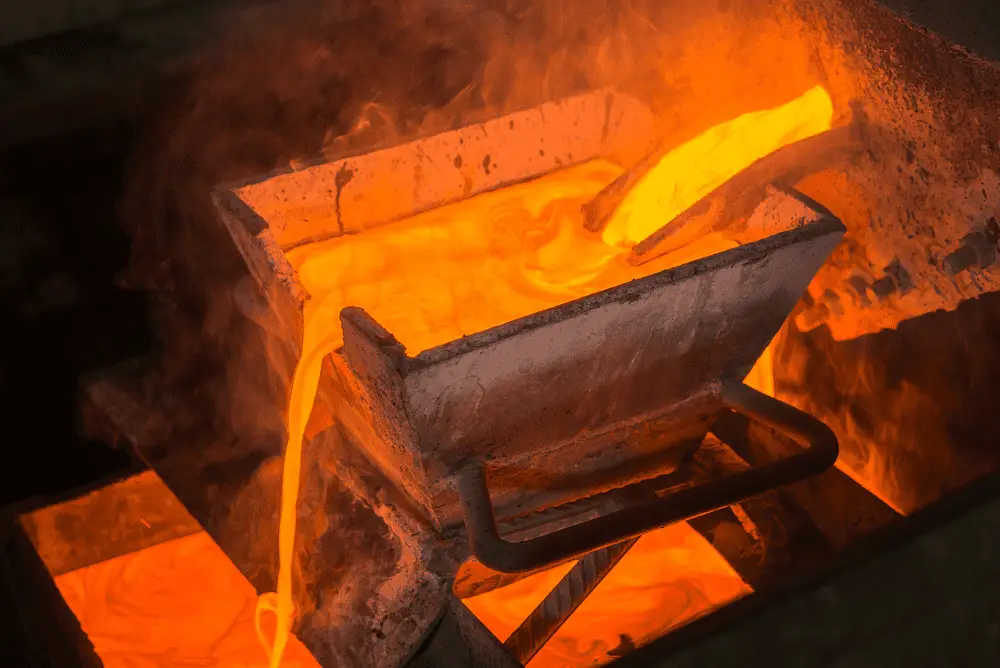Table of Contents
Gold miners must purify gold by the smelting process. This is a vital refinement process where impurities are removed, yielding pure gold. The process has been around for thousands of years. However, there are major improvements that have been included to enhance the process. This is because of advances in technology, and currently, the process is not as difficult as it used to be. So what is gold smelting and what are the steps involved? This article highlights what smelting is, its history and everything you need to know about the smelting process.
*This post may contain affiliate links. As an Amazon Associate we earn from qualifying purchases.
What Is Smelting?
Many people confuse gold smelting and melting. While melting entails heating the gold from solid to liquid form before forming gold bars, the smelting process is more complex and involves removing impurities from the gold using a combination of pressure, heat, and several chemicals.
Like any other metal that appears on earth, there are impurities in gold that need to be removed. This allows the gold to be sold or used in its purest form, which is important in many applications, such as in electronics and jewelry. Gold is utilized in electronics since it does not tarnish or rust over time as opposed to other materials. The smelting process involves ore processing and the removal of impurities.
Processing Gold Ores
Once the ore containing gold is mined from the earth, the crude binding matter and the gold metal should be separated. This is accomplished by crushing or pulverizing the gold ore and then placing it on the furnace. The ore is subjected to high temperatures, which should reach at least 1064 degrees Celsius, to elevate the gold above its melting point.
Removal of Impurities
Even though many impurities burn off in the furnace, other impurities remain. The gold ore extracted from the mines has many impurities, including traces of other metals. To separate the gold from these other metals, chemicals such as mercury or cyanide solution should be introduced in the gold. This process leads to gold coagulation, which results in nuggets or clumps of gold.
Uses of Purified Gold
After the purification process is completed, the gold is melted once more and then poured on molds to form ingots. The gold ingots are later used in a variety of processes fulfilled best by gold. Some gold, as highlighted earlier, can be used for electronics contacts or jewelry. It may later be recycled for other uses. In the event that the gold from electronics or jewelry is to be recycled, the scrap gold is subjected to another smelting process so it can be considered pure once more.
The History of Smelting Gold
Gold smelting is not a new process. In fact, it has been used for a long time, and according to ancient literature, it started as early as 6000 BC. Most sources highlight that it was in use in the ancient towns in Mesopotamia, such as Babylon, which is modern-day Syria. Heraclitus, a Greek philosopher, extensively wrote about gold smelting during the civilization of the Greek empire. Many other places, such as China, Egypt, and parts of Africa and Asia, also smelted gold thousands of years ago.
In the early days of human civilization, gold ore was dug out of the ground and crushed using simple tools. The ore was then washed in water and then gold recovered. The gold was then smelted in earthen kilns. A similar process is used today, but a few improvements have been adopted.
Everything You Need to Know About the Gold Smelting Process
The process is a long one and involves several steps as discussed below.
1. Gold Processing
The first step entails processing of the gold ore. The gold ore once mined is processed by separating the gold mineral from the crude matter holding it together. The ore is then pulverized using pressure to create very fine particles. The fine particles are then heated in a furnace to temperatures over 1,064 degrees Celsius, which is the melting point of gold. The process is useful as most of the impurities are burned off; but some metals may remain, which is why further purification is needed.
2. Pre-Smelting Chemical Removal
The gold ore contains chemicals that may be dangerous to the health of the smelter and the longevity of the equipment used. These elements are removed using chemical agents. The chemicals used include mercury and iron.
Mercury is toxic to our health when in gaseous form. Gold is recovered from the ore using the Merrill-Crowe process, or the electrowinning method, both of which use mercury traces. To remove these traces, the ore is heated in a retort.
3. Impurity removal
Once the ore is processed, chemicals are used to remove impurities, which are mainly traces of other metals. The purification process next includes the use of mercury or potassium cyanide. They make the gold coagulate, which leads to the formation of gold clumps and nuggets. This makes it easy to separate the gold.
4. Melting
Once the purification is completed, the gold is put in a furnace once more to melt. This makes it moldable, and it is formed into ingots. Before being sold, gold is cast in gold bars with various sizes, shapes, and quantity.
5. Refinement
After melting, the gold needs to be refined. This involves a variety of processes used in extracting and separating the precious metals in the mined material and from the recycled products (electronic and jewelry). The main processes used in removing the final impurities to create high cartage gold are:
Cupellation
- Removes base metals
- Does not remove silver
- Does not remove platinum group metals (PGMs)
- Used by large-scale refiners
- Used by small-scale refiners
Inquartation and Parting
- Removes base metals
- Removes silver
- Does not removes platinum group metals (PGMs)
- Not used by large-scale refiners
- Used by small-scale refiners
Miller Process
- Removes base metals
- Removes silver
- Does not removes platinum group metals (PGMs)
- Used by large-scale refiners
- Not used by small-scale refiners
Wohlwill Electrolytic Process
- Can only be used when initial gold content is about 96%
- Removes base metals
- Does not remove silver
- Does not removes platinum group metals (PGMs)
- Used by large-scale refiners
- Not used by small-scale refiners
Fizzer Cell
- Removes base metals
- Removes silver
- Removes platinum group metals (PGMs)
- Not used by large-scale refiners
- Used by small-scale refiners
Aqua Regis Process
- Only suitable when initial silver content is less than 10%
- Removes base metals
- Removes silver
- Removes platinum group metals (PGMs)
- Used by large-scale refiners
- Used by small-scale refiners
Pyrometallurgical Process
- Removes base metals (Copper remains in gold)
- Does not remove silver
- Does not remove platinum group metals (PGMs)
- Used by large-scale refiners
- Not used by small-scale refiners
Electroplating
This is a relatively new process and refines gold by separating it from other metal elements using an electrolytic cell. The cell is set in such a way that when an electric current is passed, all other metals dissolve except gold and platinum. The gold produced has 99.5% purity. Repeating the process improves gold purity.
Most Used Gold Refining Methods
The methods that are most commonly used are the Wohlwill and Miller process. The Wohlwill process increases purity by up to 99.99% by electrolysis. The impure gold is put in an electrolyte solution of gold chloride and hydrochloric acid. By use of an electric current, the gold is made to move to the cathode where it is restored to a highly pure metallic state and leaves impurities as a residue.
The Miller process uses gaseous chlorine to extract impurities when gold melts. The impurities separate into a layer on the surface of the molten and purified gold. The process is simple and rapid but produces gold with 99.5% purity.
Conclusion
Gold smelting has been used for a long time and ancient literature reveals that it started as early as 6000 BC. Gold is no less valuable now than it was all those millenia ago, and so we are just as interested in getting pure gold as the ancients ever were. Our goals are the same, but the process has changed in recent years.
The process of smelting now involves removing impurities from the gold using a combination of pressure, heat, and several chemicals. It entails ore processing and the removal of impurities. Four steps are used, including gold processing, pre-smelting chemical removal, impurity removal, and melting.
The refining process aims to achieve a high gold purity parentage. The process includes cupellation, inquartation and parting, and may use the Miller process, Wohlwill electrolytic process, fizzer cell, Aqua Regis process, or the pyrometallurgical process. The methods most commonly used are the Wohlwill and Miller process. The Wohlwill process is the best as it increases purity by up to 99.99%. We hope that this article has adequately addressed what smelting is, its history and everything you need to know about the process.

